technical specifications Seat Alhambra 2010 Owner's Manual
[x] Cancel search | Manufacturer: SEAT, Model Year: 2010, Model line: Alhambra, Model: Seat Alhambra 2010Pages: 413, PDF Size: 3.86 MB
Page 261 of 413
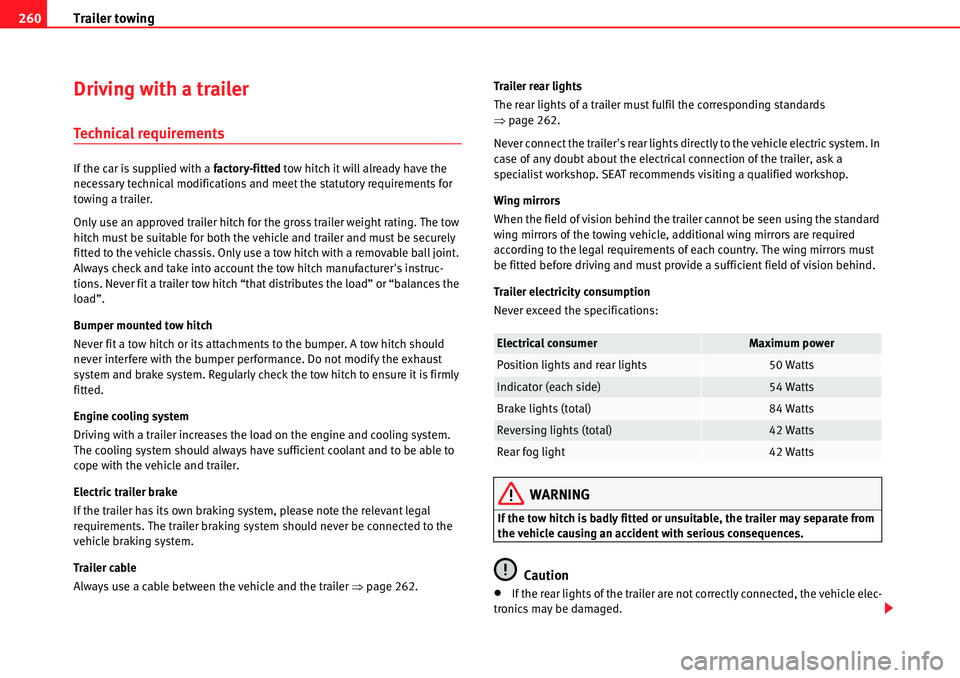
Trailer towing 260
Driving with a trailer
Technical requirements
If the car is supplied with a factory-fitted tow hitch it will already have the
necessary technical modifications and meet the statutory requirements for
towing a trailer.
Only use an approved trailer hitch for the gross trailer weight rating. The tow
hitch must be suitable for both the vehicle and trailer and must be securely
fitted to the vehicle chassis. Only use a tow hitch with a removable ball joint.
Always check and take into account the tow hitch manufacturer's instruc-
tions. Never fit a trailer tow hitch “that distributes the load” or “balances the
load”.
Bumper mounted tow hitch
Never fit a tow hitch or its attachments to the bumper. A tow hitch should
never interfere with the bumper performance. Do not modify the exhaust
system and brake system. Regularly check the tow hitch to ensure it is firmly
fitted.
Engine cooling system
Driving with a trailer increases the load on the engine and cooling system.
The cooling system should always have sufficient coolant and to be able to
cope with the vehicle and trailer.
Electric trailer brake
If the trailer has its own braking system, please note the relevant legal
requirements. The trailer braking system should never be connected to the
vehicle braking system.
Trailer cable
Always use a cable between the vehicle and the trailer �Ÿpage 262.Trailer rear lights
The rear lights of a trailer must fulfil the corresponding standards
�Ÿpage 262.
Never connect the trailer's rear lights directly to the vehicle electric system. In
case of any doubt about the electrical connection of the trailer, ask a
specialist workshop. SEAT recommends visiting a qualified workshop.
Wing mirrors
When the field of vision behind the trailer cannot be seen using the standard
wing mirrors of the towing vehicle, additional wing mirrors are required
according to the legal requirements of each country. The wing mirrors must
be fitted before driving and must provide a sufficient field of vision behind.
Trailer electricity consumption
Never exceed the specifications:
WARNING
If the tow hitch is badly fitted or unsuitable, the trailer may separate from
the vehicle causing an accident with serious consequences.
Caution
�xIf the rear lights of the trailer are not correctly connected, the vehicle elec-
tronics may be damaged.
Electrical consumerMaximum power
Position lights and rear lights50 Watts
Indicator (each side)54 Watts
Brake lights (total)84 Watts
Reversing lights (total)42 Watts
Rear fog light42 Watts
Page 286 of 413

Accessories, parts replacement and modifications285
Safety FirstOperating instructionsPractical tipsTe c h n i c a l D a t a
Accessories, parts replacement and modifications
Accessories, replacement of parts and
modifications
Introduction
WARNING
The use of spare parts and accessories, or incorrectly performed modifica-
tions or repairs may result in damage to the vehicle, accidents and serious
injury.
�xSEAT strongly recommends you to only use SEAT approved accessories
and SEAT® original spare parts. These parts and accessories have been
specially tested by SEAT for suitability, reliability and safety.
�xHave any repairs or modifications carried out at a qualified workshop.
Qualified workshops have the necessary tools, diagnostics equipment,
repair information and qualified personnel.
�xOnly mount parts with the same specifications as the parts fitted at
factory.
�xNever mount, fasten or fit objects such as drink holders or telephone
cradles over the covers of the airbag modules or within their radius of
action.
�xOnly use wheels and tyre combinations which have been approved by
SEAT for your vehicle type.
Accessories and spare parts
SEAT recommends you consult an Official Service before purchasing accesso-
ries and spare parts or consumables. For example, when fitting accessories
at a later date, or when replacing a component. A Technical Service will advise
you as to the legal requirements and manufacturer's recommendations
regarding accessories, spare parts and other components.
SEAT recommend you use only approved SEAT accessories and genuine SEAT
spare parts
®. These parts and accessories have been specially tested by
SEAT for suitability, reliability and safety. In addition the Technical Service will
guarantee that the assembly is carried out professionally.
Although we continually monitor the market, SEAT cannot guarantee that
products not approved by SEAT are reliable, safe and suitable for the vehicle.
Therefore, SEAT cannot accept liability, even in those cases authorised by an
officially recognised technical inspection office or other official body.
Any retro-fitted equipment which has a direct effect on the vehicle and/or the
way it is driven must be approved by SEAT for use in your vehicle and bear the
e mark (the European Union's authorisation symbol). This includes cruise
control systems or electronically controlled suspension.
If any additional electrical components are fitted which do not serve to
control the vehicle itself, these must bear the
�& mark (European Union
manufacturer conformity declaration). This includes refrigerator boxes,
laptops or ventilator fans.
WARNING
Unprofessional repairs or modifications to the vehicle may affect the
performance of the airbags, resulting in operating faults or fatal accident.
Page 300 of 413

Checking and refilling levels299
Safety FirstOperating instructionsPractical tipsTe c h n i c a l D a t a Whenever there is little fuel in the tank (reserve), the auxiliary heater auto-
matically switches off.
WARNING
Never use start boosters. An aerosol start booster could explode or cause
a sudden rise in engine speed leading to engine damage and serious injury.
Caution
�xThe vehicle is not prepared for the use of biodiesel. Under no circum-
stances should this fuel be used. It could damage the fuel system and subse-
quently lead to engine faults!
�xThe addition of biodiesel to diesel by the diesel producer according to
Standard EN 590 or other equivalent (DIN 51628 in Germany, for example) is
authorised and causes no type of damage to the engine or the fuel system.
�xThe diesel engine has been designed for to use diesel fuel exclusively.
Therefore, never use petrol, fuel oil or other unsuitable fuels. The composition
of these fuels may significantly damage the fuel system and the engine.
�xThe use of diesel fuels with a high sulphur percentage could considerably
reduce the service life of the diesel particulate filter. Your qualified workshop
will be able to tell you which countries have diesel with a high sulphur
content.
Information on fuel consumption
The consumption and emission values indicated do not refer to one specific
vehicle. They are only to be used to compare the values of the different
vehicle versions. The fuel consumption and CO
2 emissions of a vehicle not
only depend on the effective use of fuel. They also depend on your driving
style and other non-technical factors.Calculating fuel consumption
Fuel consumption and emission values are determined according to the
current version of the 715/2007/EC or 80/1268/EEC regulation and are valid
for the vehicle kerb weight. The specifications do not refer to an individual
vehicle. Two measuring cycles are carried out on a rolling road test bed. The
test criteria are as follows:
Note
The kerb weight may vary according to the vehicle equipment. This could
raise consumption and the CO
2 emissions slightly.
Note
In practice, consumption values could be different to the values calculated
based on the 715/2007/EC or 80/1268/EEC regulations.
Urban cycleMeasurement of the urban cycle starts with an engine cold
start. City driving is then simulated at between 0 and 50
km/h.
Road cycleIn the road cycle simulation, the car undergoes frequent
acceleration and braking in all gears, as in normal everyday
driving. The road speed ranges from 0 to 120 km/h.
CombinedThe average combined consumption is calculated with a
weighting of around 37 % for the urban cycle and 63 % for
the road cycle.
CO2 emis-
sions of the
combination The exhaust gases are collected during both driving cycles to
calculate carbon dioxide emissions (urban and road). The
gas composition is then analysed to evaluate the CO
2 con-
tent and other emissions.
Page 385 of 413
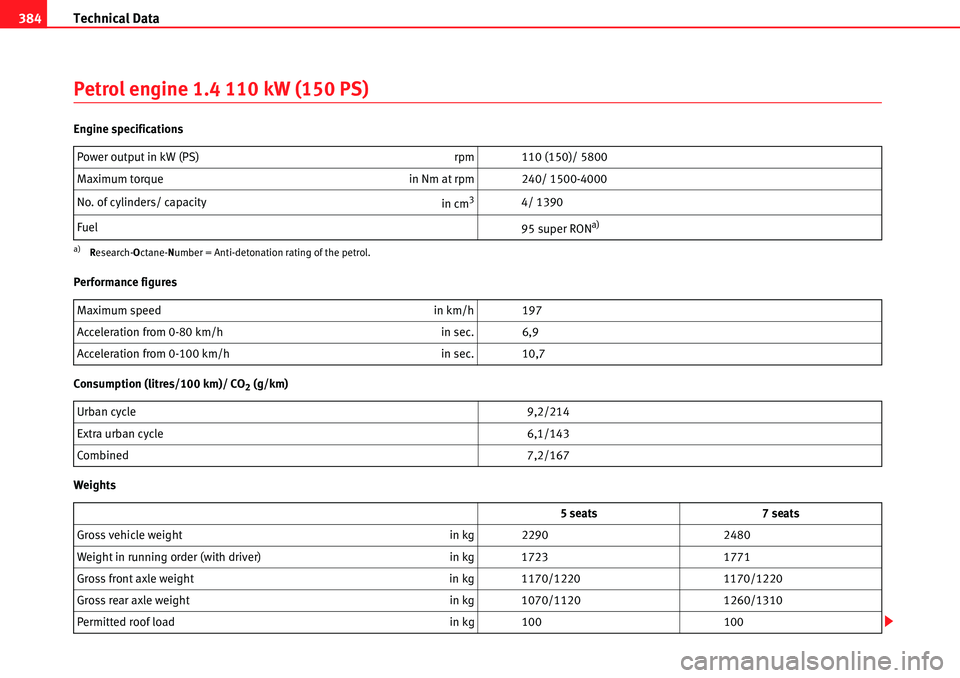
Technical Data 384
Petrol engine 1.4 110 kW (150 PS)
Engine specifications
Performance figures
Consumption (litres/100 km)/ CO
2 (g/km)
WeightsPower output in kW (PS) rpm 110 (150)/ 5800
Maximum torque in Nm at rpm 240/ 1500-4000
No. of cylinders/ capacity
in cm
34/ 1390
Fuel
95 super RON
a)
a)Research-Octane-Number = Anti-detonation rating of the petrol.
Maximum speed in km/h 197
Acceleration from 0-80 km/h in sec. 6,9
Acceleration from 0-100 km/h in sec. 10,7
Urban cycle9,2/214
Extra urban cycle 6,1/143
Combined7,2/167
5 seats 7 seats
Gross vehicle weight in kg 2290 2480
Weight in running order (with driver) in kg 1723 1771
Gross front axle weight in kg 1170/1220 1170/1220
Gross rear axle weight in kg 1070/1120 1260/1310
Permitted roof load in kg 100 100
Page 386 of 413
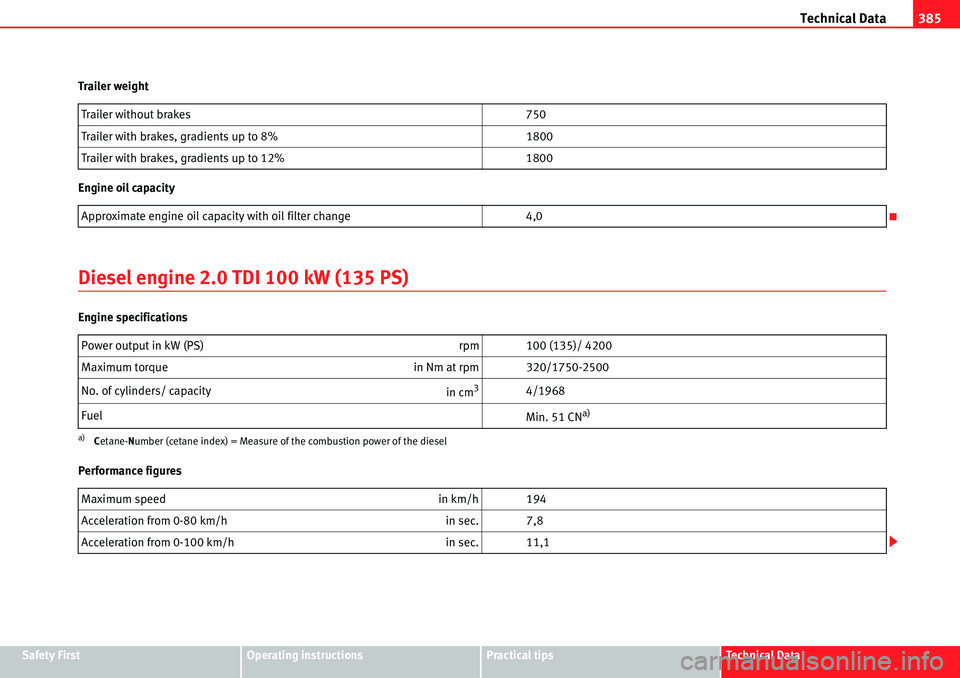
Technical Data385
Safety FirstOperating instructionsPractical tipsTe c h n i c a l D a t a Trailer weight
Engine oil capacity
Diesel engine 2.0 TDI 100 kW (135 PS)
Engine specifications
Performance figuresTrailer without brakes 750
Trailer with brakes, gradients up to 8% 1800
Trailer with brakes, gradients up to 12% 1800
Approximate engine oil capacity with oil filter change 4,0
Power output in kW (PS) rpm 100 (135)/ 4200
Maximum torque in Nm at rpm 320/1750-2500
No. of cylinders/ capacity
in cm
34/1968
Fuel
Min. 51 CN
a)
a)Cetane-Number (cetane index) = Measure of the combustion power of the diesel
Maximum speed in km/h 194
Acceleration from 0-80 km/h in sec. 7,8
Acceleration from 0-100 km/h in sec. 11,1
Page 388 of 413
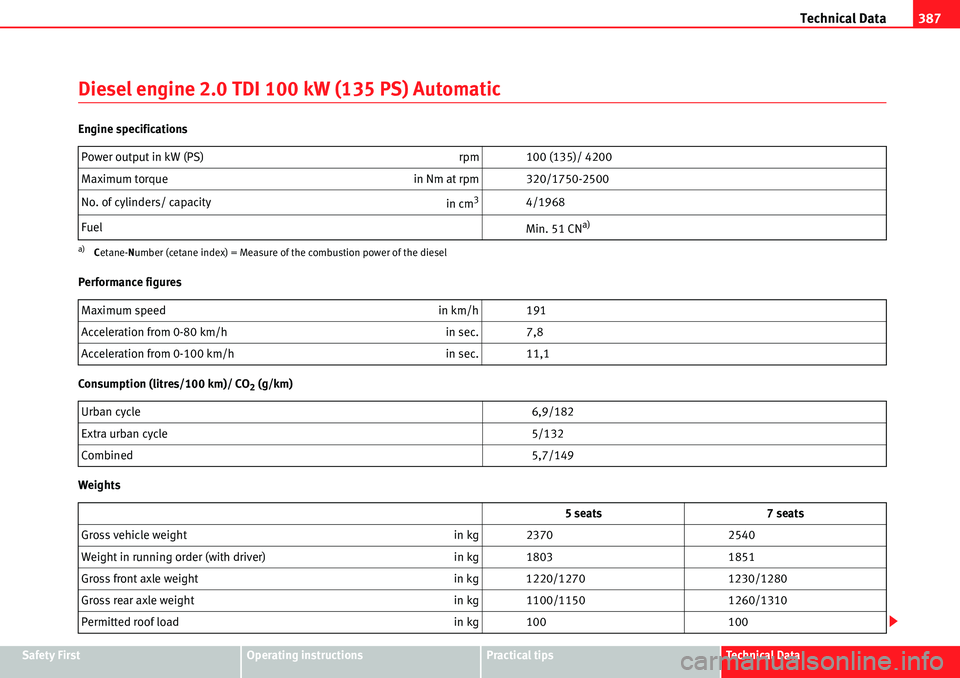
Technical Data387
Safety FirstOperating instructionsPractical tipsTe c h n i c a l D a t a
Diesel engine 2.0 TDI 100 kW (135 PS) Automatic
Engine specifications
Performance figures
Consumption (litres/100 km)/ CO
2 (g/km)
WeightsPower output in kW (PS) rpm 100 (135)/ 4200
Maximum torque in Nm at rpm 320/1750-2500
No. of cylinders/ capacity
in cm
34/1968
Fuel
Min. 51 CN
a)
a)Cetane-Number (cetane index) = Measure of the combustion power of the diesel
Maximum speed in km/h 191
Acceleration from 0-80 km/h in sec. 7,8
Acceleration from 0-100 km/h in sec. 11,1
Urban cycle6,9/182
Extra urban cycle 5/132
Combined5,7/149
5 seats 7 seats
Gross vehicle weight in kg 2370 2540
Weight in running order (with driver) in kg 1803 1851
Gross front axle weight in kg 1220/1270 1230/1280
Gross rear axle weight in kg 1100/1150 1260/1310
Permitted roof load in kg 100 100
Page 389 of 413
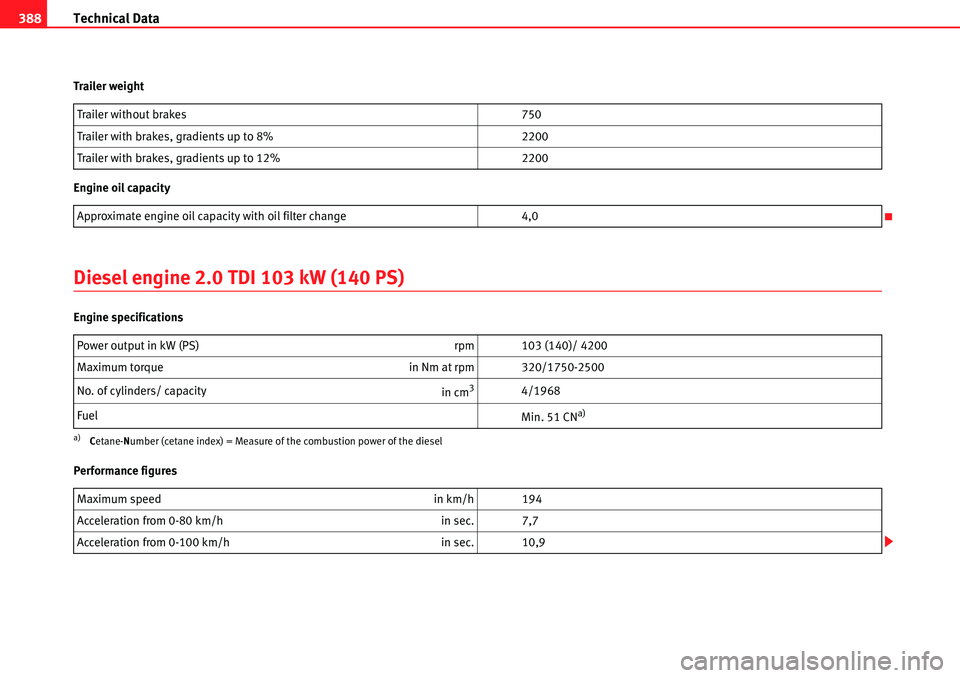
Technical Data 388
Trailer weight
Engine oil capacity
Diesel engine 2.0 TDI 103 kW (140 PS)
Engine specifications
Performance figuresTrailer without brakes 750
Trailer with brakes, gradients up to 8% 2200
Trailer with brakes, gradients up to 12% 2200
Approximate engine oil capacity with oil filter change 4,0
Power output in kW (PS) rpm 103 (140)/ 4200
Maximum torque in Nm at rpm 320/1750-2500
No. of cylinders/ capacity
in cm
34/1968
Fuel
Min. 51 CN
a)
a)Cetane-Number (cetane index) = Measure of the combustion power of the diesel
Maximum speed in km/h 194
Acceleration from 0-80 km/h in sec. 7,7
Acceleration from 0-100 km/h in sec. 10,9
Page 391 of 413

Technical Data 390
Diesel engine 2.0 TDI 103 kW (140 PS) Automatic
Engine specifications
Performance figures
Consumption (litres/100 km)/ CO
2 (g/km)
WeightsPower output in kW (PS) rpm 103 (140)/ 4200
Maximum torque in Nm at rpm 320/1750-2500
No. of cylinders/ capacity
in cm
34/1968
Fuel
Min. 51 CN
a)
a)Cetane-Number (cetane index) = Measure of the combustion power of the diesel
Maximum speed in km/h 191
Acceleration from 0-80 km/h in sec. 7,7
Acceleration from 0-100 km/h in sec. 10,9
Urban cycle6,9/182
Extra urban cycle 5/132
Combined5,7/149
5 seats 7 seats
Gross vehicle weight in kg 2370 2540
Weight in running order (with driver) in kg 1803 1851
Gross front axle weight in kg 1220/1270 1230/1280
Gross rear axle weight in kg 1100/1150 1260/1310
Permitted roof load in kg 100 100
Page 408 of 413
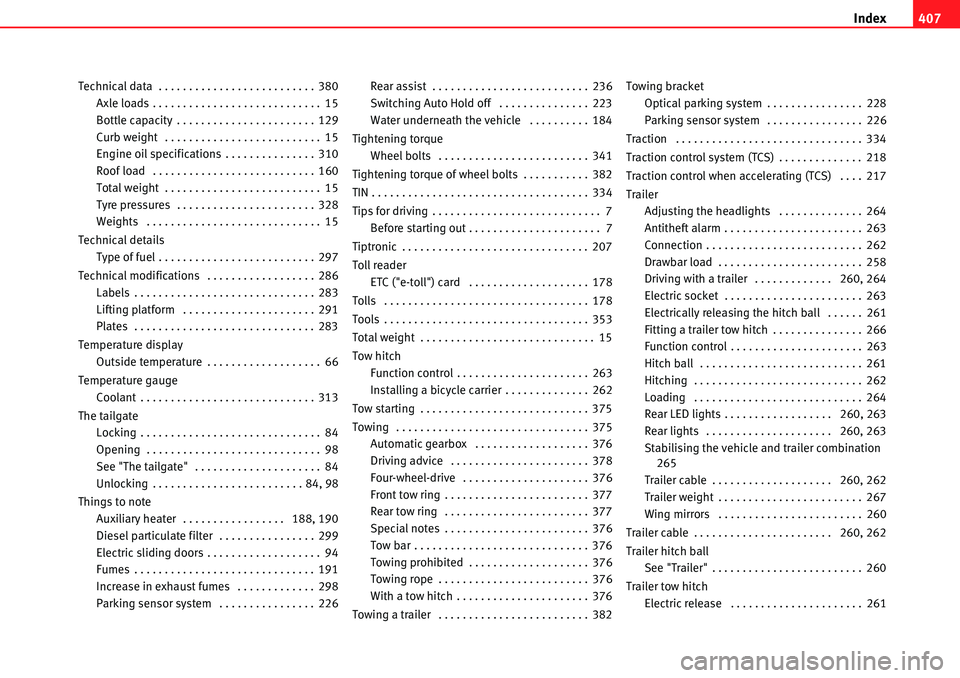
Index407
Technical data . . . . . . . . . . . . . . . . . . . . . . . . . . 380
Axle loads . . . . . . . . . . . . . . . . . . . . . . . . . . . . 15
Bottle capacity . . . . . . . . . . . . . . . . . . . . . . . 129
Curb weight . . . . . . . . . . . . . . . . . . . . . . . . . . 15
Engine oil specifications . . . . . . . . . . . . . . . 310
Roof load . . . . . . . . . . . . . . . . . . . . . . . . . . . 160
Total weight . . . . . . . . . . . . . . . . . . . . . . . . . . 15
Tyre pressures . . . . . . . . . . . . . . . . . . . . . . . 328
Weights . . . . . . . . . . . . . . . . . . . . . . . . . . . . . 15
Technical details
Type of fuel . . . . . . . . . . . . . . . . . . . . . . . . . . 297
Technical modifications . . . . . . . . . . . . . . . . . . 286
Labels . . . . . . . . . . . . . . . . . . . . . . . . . . . . . . 283
Lifting platform . . . . . . . . . . . . . . . . . . . . . . 291
Plates . . . . . . . . . . . . . . . . . . . . . . . . . . . . . . 283
Temperature display
Outside temperature . . . . . . . . . . . . . . . . . . . 66
Temperature gauge
Coolant . . . . . . . . . . . . . . . . . . . . . . . . . . . . . 313
The tailgate
Locking . . . . . . . . . . . . . . . . . . . . . . . . . . . . . . 84
Opening . . . . . . . . . . . . . . . . . . . . . . . . . . . . . 98
See "The tailgate" . . . . . . . . . . . . . . . . . . . . . 84
Unlocking . . . . . . . . . . . . . . . . . . . . . . . . . 84, 98
Things to note
Auxiliary heater . . . . . . . . . . . . . . . . . 188, 190
Diesel particulate filter . . . . . . . . . . . . . . . . 299
Electric sliding doors . . . . . . . . . . . . . . . . . . . 94
Fumes . . . . . . . . . . . . . . . . . . . . . . . . . . . . . . 191
Increase in exhaust fumes . . . . . . . . . . . . . 298
Parking sensor system . . . . . . . . . . . . . . . . 226Rear assist . . . . . . . . . . . . . . . . . . . . . . . . . . 236
Switching Auto Hold off . . . . . . . . . . . . . . . 223
Water underneath the vehicle . . . . . . . . . . 184
Tightening torque
Wheel bolts . . . . . . . . . . . . . . . . . . . . . . . . . 341
Tightening torque of wheel bolts . . . . . . . . . . . 382
TIN . . . . . . . . . . . . . . . . . . . . . . . . . . . . . . . . . . . . 334
Tips for driving . . . . . . . . . . . . . . . . . . . . . . . . . . . . 7
Before starting out . . . . . . . . . . . . . . . . . . . . . . 7
Tiptronic . . . . . . . . . . . . . . . . . . . . . . . . . . . . . . . 207
Toll reader
ETC ("e-toll") card . . . . . . . . . . . . . . . . . . . . 178
Tolls . . . . . . . . . . . . . . . . . . . . . . . . . . . . . . . . . . 178
Tools . . . . . . . . . . . . . . . . . . . . . . . . . . . . . . . . . . 353
Total weight . . . . . . . . . . . . . . . . . . . . . . . . . . . . . 15
Tow hitch
Function control . . . . . . . . . . . . . . . . . . . . . . 263
Installing a bicycle carrier . . . . . . . . . . . . . . 262
Tow starting . . . . . . . . . . . . . . . . . . . . . . . . . . . . 375
Towing . . . . . . . . . . . . . . . . . . . . . . . . . . . . . . . . 375
Automatic gearbox . . . . . . . . . . . . . . . . . . . 376
Driving advice . . . . . . . . . . . . . . . . . . . . . . . 378
Four-wheel-drive . . . . . . . . . . . . . . . . . . . . . 376
Front tow ring . . . . . . . . . . . . . . . . . . . . . . . . 377
Rear tow ring . . . . . . . . . . . . . . . . . . . . . . . . 377
Special notes . . . . . . . . . . . . . . . . . . . . . . . . 376
Tow bar . . . . . . . . . . . . . . . . . . . . . . . . . . . . . 376
Towing prohibited . . . . . . . . . . . . . . . . . . . . 376
Towing rope . . . . . . . . . . . . . . . . . . . . . . . . . 376
With a tow hitch . . . . . . . . . . . . . . . . . . . . . . 376
Towing a trailer . . . . . . . . . . . . . . . . . . . . . . . . . 382Towing bracket
Optical parking system . . . . . . . . . . . . . . . . 228
Parking sensor system . . . . . . . . . . . . . . . . 226
Traction . . . . . . . . . . . . . . . . . . . . . . . . . . . . . . . 334
Traction control system (TCS) . . . . . . . . . . . . . . 218
Traction control when accelerating (TCS) . . . . 217
Trailer
Adjusting the headlights . . . . . . . . . . . . . . 264
Antitheft alarm . . . . . . . . . . . . . . . . . . . . . . . 263
Connection . . . . . . . . . . . . . . . . . . . . . . . . . . 262
Drawbar load . . . . . . . . . . . . . . . . . . . . . . . . 258
Driving with a trailer . . . . . . . . . . . . . 260, 264
Electric socket . . . . . . . . . . . . . . . . . . . . . . . 263
Electrically releasing the hitch ball . . . . . . 261
Fitting a trailer tow hitch . . . . . . . . . . . . . . . 266
Function control . . . . . . . . . . . . . . . . . . . . . . 263
Hitch ball . . . . . . . . . . . . . . . . . . . . . . . . . . . 261
Hitching . . . . . . . . . . . . . . . . . . . . . . . . . . . . 262
Loading . . . . . . . . . . . . . . . . . . . . . . . . . . . . 264
Rear LED lights . . . . . . . . . . . . . . . . . . 260, 263
Rear lights . . . . . . . . . . . . . . . . . . . . . 260, 263
Stabilising the vehicle and trailer combination
265
Trailer cable . . . . . . . . . . . . . . . . . . . . 260, 262
Trailer weight . . . . . . . . . . . . . . . . . . . . . . . . 267
Wing mirrors . . . . . . . . . . . . . . . . . . . . . . . . 260
Trailer cable . . . . . . . . . . . . . . . . . . . . . . . 260, 262
Trailer hitch ball
See "Trailer" . . . . . . . . . . . . . . . . . . . . . . . . . 260
Trailer tow hitch
Electric release . . . . . . . . . . . . . . . . . . . . . . 261